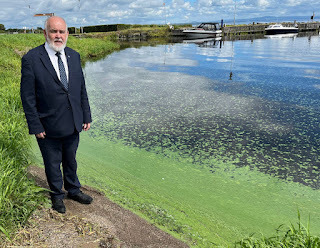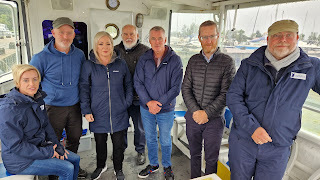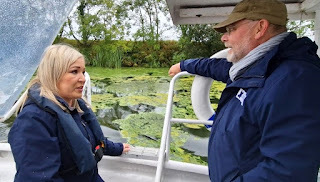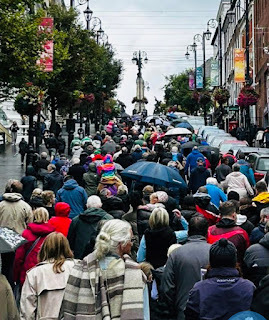Lough Neagh facing an ecological disaster: Tory backing for Pinochet: Siúlóid An Taoisigh.
Mid Ulster MP Francie Molloy at Lough Neagh
Lough Neagh facing an ecological disaster
Upthe Shore
i
The lough will claim avictim every year.
It has virtue thathardens wood to stone.
There is a town sunkbeneath its water.
It is the scar left bythe Isle of Man.
ii
At Toomebridge whereit sluices towards the sea
They’ve set new gatesand tanks against the flow.
From time to time theybreak the eels’ journey
And lift five hundredstones in one go.
iii
But up the shore inAntrim and Tyrone
There is a sense offair play in the game.
The fishermen confrontthem one by one
And sail miles out andnever learn to swim.
Iv
‘We’ll be the quickergoing down,’ they say.
And when you arguethere are no storms here,
That one hourfloating’s sure to land them safely –
‘The lough will claima victim every year.’
Seamus Heaney’s poem, published in 1969, capturesmuch of what makes Lough Neagh unique. It has long been a place of myth and fable,where the palace of the Tuatha Dé Danann is supposed to lie beneath its waves.It is said that Lough Neagh was created by the giant Finn McCool who legendclaims scooped out a huge chunk of earth and threw it after the Scottish giantBenandonner. He missed and thus created the Isle of Man. Richard believes thatthe Lough was created 400 million years ago as a result ofmassive tectonic events.
People have lived and worked around the shoresof Lough Neagh for thousands of years. This is evident in thehuge number of artefacts and ruins. Stone axes have been foundat Toome and Shanes Castle. Neolithic pottery has also beenfound at Newferry north of Toome.
In the ninth century the Lough was a base for aViking fleet as part of their efforts to occupy Ireland.
Following the English invasion of Ireland theshores of Lough Neagh have witnessed many battles. It played a strategicallyimportant role in the English defeat of the O’Neill and O’Donnell clans in thelate 16th century and in the subsequent plantation of Ulster.
The Lough is the largest fresh water lake inIreland. It is home to many rare plants, waterfowl and fish. It is bordered byfive counties – Antrim, Down, Armagh, Tyrone and Derry. For millennia it hasbeen at the heart of the local economy. A transport hub before roads and amajor source of fishing that has provided a living for the generations who havelived around its’ almost 400 square kilometres. It is a significant culturaland historic site and in more recent years a place for water sports andrelaxation for tens of thousands. It also provides 40% of the fresh water forcitizens living in the North.
Today all of that is under threat. Recent satelliteimages have shown the extent to which a toxic blue green algae has infested theLough. Cyanobacteria is a danger to animals and humans. According to the LoughNeagh Partnership climate change and the increased water temperature of theLough has created the conditions for this algae to thrive.
In addition millions of tons of sand have beendredged from the floor of the Lough for building projects here and in Britain.In an article by Tommy Green in The Detail last December he reported thataround 30% of the North’s “construction sand comes from Lough Neagh … Priorto 2021, when extraction was unregulated, it is estimated that at least 1.1m-1.8m tonnes were being dredged from the Lough every year…”
Sinn Féin team meet Lough Neagh Partnership
The Lough Neagh Fishermen’s Co-operative Societywarned last year that sand extraction was destroying habitat areas on the floorof the Lough and that this was reducing the number of fish. Theimpact of the climate crisis, the presence of a toxic algae, the incidence ofraw sewage and the dredging of the Lough floor and the destruction of thatcritical underwater environment, mean that Lough Neagh is now facing anecological disaster.
With 40% of the North’s population relying on LoughNeagh for fresh, clean water there is mounting concern that none of thegovernment departments are prepared for or appear willing to take the stepsnecessary to protect this hugely important community and environmental asset.
Last week First Minister designate MichelleO’Neill, Francie Molloy MP, Declan Kearney MLA and Philip McGuigan MLA met withthe Lough Neagh Partnership. Later Declan Kearney led a political andcommunity delegation, including Philip McGuigan, locally based councillors,fishermen, anglers and the Lough Neagh Partnership, to meet seniorofficials of the NI Environment Agency and Inland Fisheries.
The message is clear. As Mid Ulster MP FrancieMolloy said: “The situation is untenable. The Lough needs to be brought intopublic ownership and managed by a community partnership.” Thismust include the bed of the Lough which is currently owned by an absenteeBritish Earl who receives royalty payments for every tonne of sands extractedfrom the bed of the Lough.
There is also an urgent need for a comprehensiveand co-ordinated action plan to tackle the toxic algae. A multi-agency andinter-departmental task force is a priority. Public ownership will facilitate aclear management structure to provide immediate and long-term plans to keep theLough safe and sustainable for future generations.
When I was a young lad a gang of us from Ballymurphy led by Joe Mageeused to walk to Lough Neagh and spend the day there. Decades later in Long Keshsome of us used to feast on Lough Neagh eels sent to us by the bucket full. Thestory of Lough Neagh is an integral part of the story and history andenvironment of the island of Ireland. The ecological crisis it currently facesarises from the actions of human beings. It is our responsibility to changethat.
Michelle O'Neill with the Gerry Darby of the Lough Neagh Partnership
Tory backing for Pinochet
Many of my generation will remember the militarycoup in Chile in September 1973 that overthrew the socialist President of ChileSalvador Allende. The images of the bombing of the Presidential Palace, of anarmed and courageous Allende defending the building and the quickly emergingreports of brutality by the Chilean military, horrified many around the world.
The coup was led by General Augusto Pinochet incollusion with the CIA. In the years that followed Chile became a byword insummary executions, torture and repression. Almost 20 years later when theregime fell a truth commission revealed that 40,000 people had been tortured,200,000 had been forced to flee the country and at least 3,000 werekilled.
The British government led Edward Heath stronglysupported the junta. Foreign Secretary Alec Douglas Home wrote that: “ForBritish interests … there is no doubt that Chile under the junta is a betterprospect … and the sky-high price of copper (important to us) should fall asChilean production is restored.” One third of Britain’s copper importscame from Chile. Allende’s nationalisation of the copper industry in July 1971had been condemned by the USA and Britain.
The Labour government that followed Heath imposedsanctions on Chile but during Margaret Thatcher’s tenure as Prime Minister sherestored diplomatic relations; authorised visits by British Ministers to Chile;and lifted the arms embargo. Hundreds of members of the Chilean armed forceswere trained by the British and in September 1982 the Thatcher governmentrefused to support a motion at the UN condemning Pinochet’s human rightsabuses. British political and economic interest once again trumped human rightsand international law.
In October 1998 Pinochet was arrested in London.Not surprisingly Margaret Thatcher campaigned hard to secure his release. Hewas returned to Chile in March 2000. By their friends we will know them.
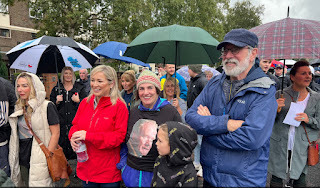
SiúlóidAn Taoisigh.
Thiscolumn had a great day out in Derryat The Chieftain’s Walk organisedby The Martin McGuinness Peace Foundation and Martin’s family led by his wifeBernie. There was a similar event in New York. Well done to all involved. Itwas good to meet many of Martin’s old friends and to walk the ground he trod onmany, many times. Despite the rain there was a great turn out.
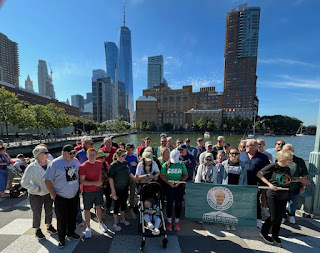
New York
Derry
Gerry Adams's Blog
- Gerry Adams's profile
- 29 followers


